Creativity and The NeverEnding Story
And Why We Cried Over a Horse [Special Edition: June 2025]
Author Notes:
Contains spoilers.
Discusses grief, animal death, and parental loss.
Correction: Stated Artax’s appearance was less than 1% of the runtime. It is actually 5% and is still remarkably small. Sentence corrected and rephrased for clarity.
A Family Movie Night and Big Questions
I finally watched The NeverEnding Story (1984) with my two children. The idea for watching the film was sparked, in part, by this post.1 However, watching old shows and films with my kids is something we already enjoy.
With no preamble or trailer, we started the movie. I predicted my preteen might lose interest because of the cheesy costumes and special effects. I also predicted my big-feeling nine-year-old wouldn’t make it past the opening scene where bullies forced Bastian into a dumpster bin.
My predictions were wrong.
I never imagined either of them would’ve watched long enough to reach Artax’s heartbreaking off-screen death. But surprisingly, both were captivated by—and thoroughly enjoyed this 40-year-old fairy tale to the very end!
The stand-out scene wasn’t Bastian’s victorious flight on Falkor, the Luck Dragon. Nor was it Atreyu coming face-to-face with his nemesis, G’mork either. Unsurprisingly, the standout moment was Atreyu’s last goodbye to Artax in the Swamp of Sadness. That scene generated the most conversation between the three of us.
As my son began to put together the pieces about Artax’s fate, he reacted audibly: “Oh no! The horse won’t make it?”
(I think I said something like: “He doesn’t, but it turns out okay in the end.”)2
My daughter, on the other hand, didn’t say a word until Atreyu was rescued by Falkor. “I want to see what happened to the horse before he died in the mud.” She had joined us slightly later, missing the happy part of Atreyu and Artax’s friendship.
As we discussed Artax’s death, my son was surprised by Bastian’s strong reaction.3 “I don’t get it. Why’s Bastian so sad?”
And later: “Why isn’t Atreyu knee-deep in the swamp after he loses Artax?”
The answer to those questions are why this scene is so creatively brilliant. But first, let’s dig into why it works at all.4
A Little Backstory
When the film came out, I was only a toddler and never got to see it on the big screen. However, watching the movie on repeat on a grainy VHS tape didn’t diminish the story’s impact on my childhood. Of course, I remembered the movie’s plot in detail. But until this past weekend, I didn’t realize how short the movie is.
The NeverEnding Story clocks in at just over 90 minutes with converging parallel storylines. The first story is about Bastian in the real world. After hiding from bullies, Bastian finds the book titled The NeverEnding Story. On the surface, that’s all he’s hiding from bullies. In reality, he lacks the courage to dream since his mother died. The second story is Atreyu’s journey. He is Fantasia’s last hope to defeat the insatiable Nothing and save the ailing Child Empress whose health is linked to their land. Atreyu must complete both quests before Fantasia disappears forever. That’s a lot of story to cover in a kids’ film in under two hours.
Editing helps in that department. The film moves along at a fairly quick pace, speeding through the plot with swift cut scenes, Bastian’s narrative voice-overs, and periods of peppy music. However, when it comes to the Swamp of Sadness, the pacing is starkly different.
The Horse That Made Us Cry
By far, Artax’s story arc is an example of masterful pacing.
He’s on screen for barely 5 minutes—that’s 5% of the entire film!5 Despite limited time and no speaking lines, this character impacted many kids growing up in the late 80s—as well as my 21st-century kids. What profound storytelling, indeed.6
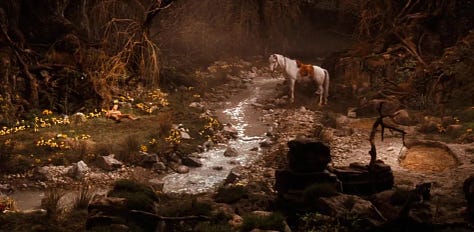
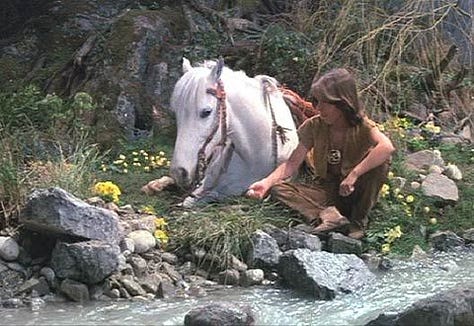
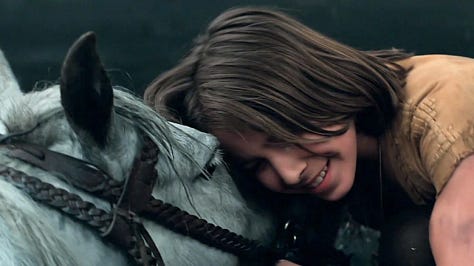
Being able to elicit an emotional reaction from an audience is a storytelling jackpot. And Artax’s scene drops gold.
5 Reasons Why That Horse Made Us Cry
#1 We understand Atreyu’s bond with Artax.
Once Atreyu accepts his mission, he rides off with Artax, his horse and companion. Throughout their journey, Atreyu affectionately calls him “boy,” talks with Artax like a friend, and says, “I love you.” In a few simple words, we know everything we need.
#2 We can infer Atreyu’s and Artax’s shared history.
Atreyu and Artax have done this before. Artax is no colt and Atreyu is barely a young teen, but they ride epic distances with ease. Throughout their journey across Fantasia neither Atreyu nor Artax looks uncomfortable. My favorite moment is when Artax’s mane and Atreyu’s hair billows in the wind like they are truly one.7 It’s safe to assume this isn’t their first rodeo. With that level of comfort, they must have history.
Creativity-in-Action: Days pass in seconds. The creative use of set changes from deserts, mountains, and forests shows the audience how much ground they’ve covered. The music is heroic and hopeful. The wide camera shots underscore Artax’s freedom as he gallops.
#3 We can see Artax’s loyalty.
When Atreyu oversleeps, Artax nuzzles him. Before they set off again, they share a peaceful lunch, almost like a cozy picnic. But when it’s time head out again, Artax doesn’t hesitate. He seems unstoppable. Even when they first enter the Swamp of Sadness, Artax does react or buck in fear. Artax trusts Atreyu.
#4 We can see the danger before Atreyu and Artax do.
The only clue Atreyu is given to complete his quest is to seek guidance from an ancient being named Morla. After searching through Fantasia, the duo are forced to enter the Swamp of Sadness. While trudging through muddy waters, Artax moves slower and slower. This majestic white horse can’t run freely here. And for those paying attention: the mud rises higher on poor Artax’s body. Meanwhile, Atreyu has no clue his friend’s on the verge of despair.
Creativity-in-Action: Less than three minutes pass between the start of the swamp scene and Artax's untimely end. Yet, it’s enough time for us to take in the foreshadowing of dreary trees and dark sky. We can feel the duo’s exhaustion with close-ups of their muddy legs aimlessly trudging on.
#5 We can understand Atreyu’s and Artax’s heart-wrenching emotions.
Once Atreyu realizes that Artax has stalled, he (in that child-like way) suggests changing their direction because the immediate path is too difficult. The solution must be an easy one. But when Artax refuses to move, Atreyu’s calm gives way to panic, which passes between them like a contagion. The most terrible part of the scene is the genuine fear in the horse’s eyes. As the two run out of options, Atreyu gives Artax one last tearful hug.
Creativity-in-Action: When the music breaks the eerie silence, a slow, haunting synth includes this drum that sounds like a heartbeat. Finally, when the drum stops, it’s like Artax’s heart gives out.
My Response to Big Questions
I’m sure my son (a.k.a the movie critic) picked up on most of those story elements I mentioned. To wrap up my family’s story, I want to share the answers I gave those big questions:
Why did Bastian cry?
Why didn’t Atreyu immediately sink in the swamp?
#1 Bastian cried not just for Artax—but his mother, too.
If you recall, the movie opens with Bastian having recurring nightmares about his deceased mother. The exposition continues with an unhelpful talk from his father, reminding him to “move on.”8 We don’t know how long Bastian’s mother has been gone—and frankly, grief isn’t linear anyway—but at that point, he’s having a hard time.
As a child, I missed that nuance. And even during my college rewatch, my mother was battling cancer, so I might not have consciously interpreted the scene quite that way.9 However, after losing both parents, Bastian’s grief over the loss of his mother was so painfully obvious to me.
#2 Atreyu didn’t sink after losing Artax because he still had hope.
Atreyu had accepted the responsibility of his quest to save Fantasia. So he pushed forward and ignored his grief. He still had some hope left.
But that hope was stripped away after speaking to Morla.
Atreyu didn’t yet know how impossibly far he had to travel. With time running out, 10,000 miles from that awful swamp might as well have been a million.
A Bonus Answer
While we didn’t explicitly talk about Falkor’s rescue or Bastian’s relief afterwards, I imagine both kids felt the same. I know I did when I was a kid.
Therefore, I’d like to end with my take on why the Swamp of Sadness scenes could still offer hope.
#3 Atreyu was never alone.
Of course, there was no possible way Atreyu could walk 10,000 miles. No matter how hard he tried. The only way Atreyu could escape the Swamp of Sadness to continue the quest would be by leaning on the strength and help of a new friend.10
I’ll continue to discuss this life lesson with my kids. But it’s really awesome when movies like The NeverEnding Story remind us that we need friends like Artax and Falkor.11 And ideally, we need to be there for others.
About Melissa Mwai
For more about my books, critique services, or school visit offerings, check out my website.
At least I was prepared for this emotional scene, unlike our family viewing of The Wild Robot, which had us all soggy. Bring tissues.
I have cried while reading books. That’s one special reading experience.
To me, there’s real value in thinking deeply about the works of Art that move us. That understanding helps us become more creative and respect the ingenuity of a master at their craft.
In total, the travel scenes with Artax are about 130 seconds (a tad over 2 min). Artax appears in the Swamp of Sadness for about 166 seconds (almost 3 min). And when Artax runs again, it’s about 20 seconds long.
And if you’re an author or illustrator, study this minor character arc and where it fits in the Hero’s Journey.
That imagery of the galloping white horse reminds us of myths and legends. In other stories, Artax could be a unicorn or a pegasus.
Here’s some practical advice for supporting a grieving person. If you aren’t sure what to say that’s okay, a quiet moment, hug, or asking them what they want to talk about would likely be appreciated.
Had I watched it after her passing, I would have bawled. This film was one of her favorites and we watched it many times together.
Yes, I know Falkor’s a luck dragon, but I prefer the interpretation that being saved from despair is more substantial than mere coincidence.
I prefer to have these family conversations in context to of the books or movies we experience. It feels less preachy and allows us to reinforce critical thinking about the media we take in.
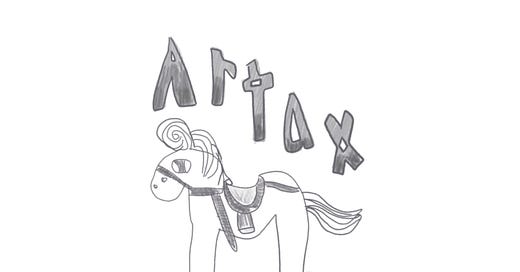




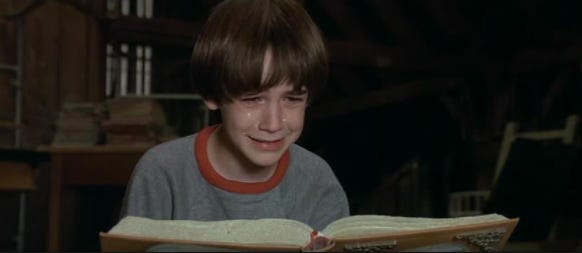
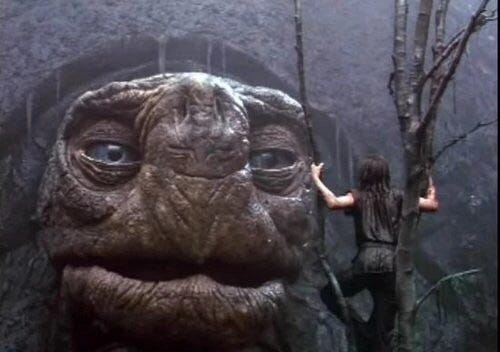
Loved this, Melissa! Though I have rewatched as an adult, there’s so much I hadn’t reflected on, probably because my viewings were so informed by countless watches on a VHS tape too. I loved this invitation to dive deeper next time and so appreciate your insights. Thanks for the shout out!